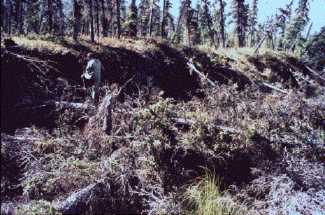Climate Change Impacts in Alaska
Alaska, like many other areas of the world, experienced a shift to warmer temperatures in the late 1970s. The magnitude of this recent shift, as well as the rate of climate warming and projected future changes, pose a host of problems and opportunities, some with international economic implications, for the people of Alaska.
 Melting permafrost is altering the boreal forest near Tok, Alaska. Photo courtesy of T. Osterkamp, University of Alaska, Fairbanks
|
|
Air temperatures for Barrow, Nome, Fairbanks, and Anchorage increased two degrees
C. around 1977 and the increases have persisted. The extent of sea ice decreased about
five percent in 1977 and has remained that way; sea ice thickness may also have been
reduced. Precipitation has increased for most of Alaska, except for the southeastern part
of the state and summer precipitation in the interior, particularly around Fairbanks.
Boreholes reveal that permafrost temperatures in northern Alaska have increased two
to four degrees C. above temperatures 50-110 years ago; permafrost has thawed in some
places where it is discontinuous. The 30-year air temperature record shows that increases
are greatest in winter and spring and in the interior of Alaska and north of the Brooks
Range.
With further warming in Alaska, a variety of consequences are possible. The location, volume, and species mix of fish catches could change, causing stress as the industry deals with relocation of harvesters and processors. While the permafrost is melting, the maintenance cost for pipelines could increase, but construction costs could decline once it is melted. The loss of sea ice could reduce oil and gas offshore exploration and production costs and improve shipping, but coastal erosion could increase due to higher sea levels and increased storm intensity.
A longer growing season could improve agriculture and forestry yields but warmer
temperatures and increased summer drying could increase flammable vegetation, thus
increasing the potential for more forest fires. While warmer weather could bring a
longer tourist season, degraded attractions due to melted glaciers and fires could offset
the benefit. A warmer climate could also result in changes in the need for government services as
local income declines due to a decline or loss of subsistence resources.
For More Information
U.S. Department of the Interior
U.S. Geological Survey
This page is <http://esp.cr.usgs.gov/info/assessment/alaska.html>
Maintained by Randy Schumann
Last modified Wednesday, 15-Mar-2006 14:38:42 MST